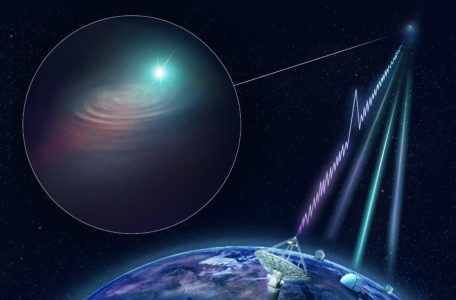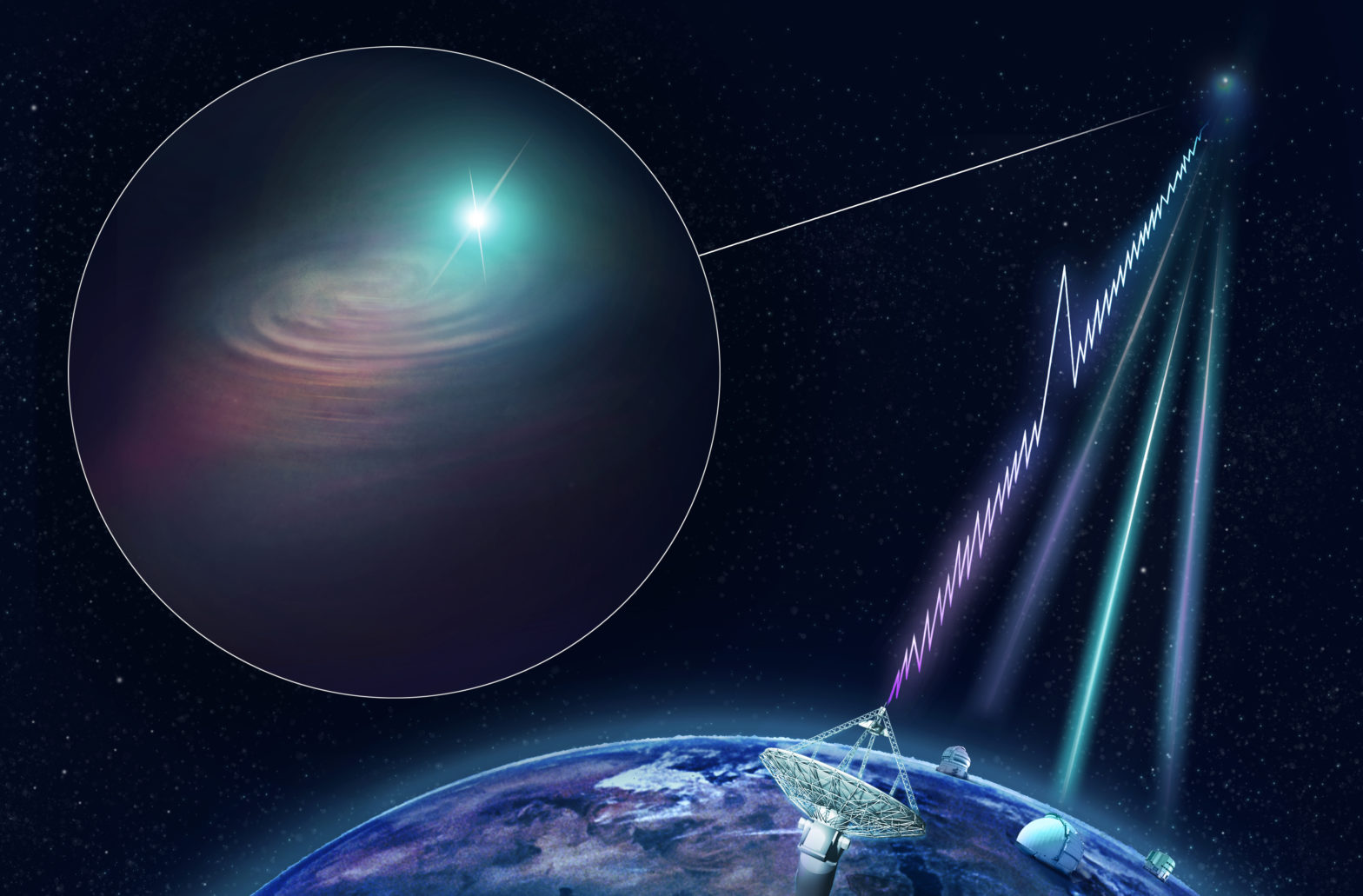27 June 2019
Optical telescopes image origin of FRB detected by SKA pathfinder ASKAP
AnAustralian-led international team of astronomers has determined the precise location of a powerful one-off burst of cosmic radio waves. The discovery was made with CSIRO’s new Australian Square Kilometre Array Pathfinder (ASKAP) radio telescope in Western Australia. The galaxy from which the burst originated was then imaged by three of the world’s largest optical telescopes – Keck, Gemini South and ESO’s Very Large Telescope.
The results were announced this week by PhD student Wael Farah (Swinburne University, Melbourne, Australia) at the annual meeting of the European Astronomical Society (EWASS2019) in Lyon, France, and will be published tomorrow in Science.
“This is the big breakthrough that the field has been waiting for since astronomers discovered fast radio bursts in 2007,” CSIRO lead author Keith Bannister said. In the 12 years since then, a global hunt has netted 85 of these bursts. Most have been ‘one-offs’ but a small fraction are ‘repeaters’ that recur in the same location. In 2017 astronomers found a repeater’s home galaxy but localizing a one-off burst has been much more challenging.

Fast radio bursts last less than a millisecond, making it difficult to accurately determine where they have come from. Bannister’s team developed new technology to freeze and save ASKAP data less than a second after a burst arrives at the telescope. This technology was used to pinpoint the location of FRB 180924 to its home galaxy (DES J214425.25−405400.81). The team made a high-resolution map showing that the burst originated in the outskirts of a Milky Way-sized galaxy about four billion light-years away.
“If we were to stand on the Moon and look down at the Earth with this precision, we would be able to tell not only which city the burst came from, but which postcode – and even which city block,” Bannister said.
ASKAP is an array of multiple dish antennas and the burst had to travel a different distance to each dish, reaching them all at a slightly different time. “From these tiny time differences – just a fraction of a billionth of a second – we identified the burst’s home galaxy and even its exact starting point, 13,000 light-years out from the galaxy’s centre in the galactic suburbs,” team member Adam Deller of Swinburne University of Technology said.
To find out more about the home galaxy, the team imaged it with the European Southern Observatory’s 8-m Very Large Telescope in Chile and measured its distance with the 10-m Keck telescope in Hawai’i and the 8-m Gemini South telescope in Chile.
The only previously localised burst, the ‘repeater’ is coming from a very tiny galaxy that is forming lots of stars. “The burst we localised and its host galaxy look nothing like the ‘repeater’ and its host,” Deller said. “It comes from a massive galaxy that is forming relatively few stars. This suggests that fast radio bursts can be produced in a variety of environments, or that the seemingly one-off bursts detected so far by ASKAP are generated by a different mechanism to the repeater.”

The cause of fast radio bursts remains unknown but the ability to determine their exact location is a big leap towards solving this mystery. Team member Jean-Pierre Macquart (Curtin University node of the International Centre for Radio Astronomy Research (ICRAR)) is an expert on using fast radio bursts to probe the Universe. “These bursts are altered by the matter they encounter in space,” Macquart said. “Now we can pinpoint where they come from, we can use them to measure the amount of matter in intergalactic space.” This would reveal material that astronomers have struggled for decades to locate.
The localisation of the radio burst was done as part of a project using ASKAP called CRAFT (Commensal Real-time ASKAP Fast Transients) that is jointly led by Bannister, Macquart and Ryan Shannon of Swinburne University of Technology. Shannon and CSIRO’s Shivani Bhandari carried out the observations and were the first to spot the burst.
Evan Keane, SKA Project Scientist and winner of the MERAC Prize for Observational Astrophysics as of today for his groundbreaking work on FRBs, has been closely involved in the field and mentioned the result in his lecture today: “In order to fully exploit the potential of FRBs as cosmological probes, it’s essential to be able to localise them this precisely, and ASKAP has done just that for the first time. It’s an amazing step for FRB science. The ultimate goal will be to go deeper in redshift and localise thousands of FRBs, this is where SKA will come in.”
—————————————————————————————————
Media contacts:
Annabelle Young, CSIRO, Australia
E-mail: Annabelle.young@csiro.au
Tel: +61 2 9372 4270
Mobile:0403 928 102
EAS:
Marieke Baan
E-mail: ewass-press@kuoni-congress.info
Mobile: +31614322627
Visuals:
Artist’s impression of CSIRO’s Australian SKA Pathfinder (ASKAP) radio telescope finding a fast radio burst and determining its precise location. The KECK, VLT and Gemini South optical telescopes joined ASKAP with follow-up observations to image the host galaxy. Credit: CSIRO/Dr Andrew Howells
CSIRO’s Australian Square Kilometre Array Pathfinder (ASKAP) radio telescope, located at CSIRO’s Murchison Radio-astronomy Observatory in Western Australia. Credit: CSIRO/Dragonfly Media
Links:
www.csiro.au
At the annual meeting of the European Astronomical Society (EWASS2019) over 1200 astronomers are gathered 24-28 June in Lyon, France.
More information about the EAS annual meeting: https://eas.unige.ch/EWASS2019/
More information about the EAS: http://eas.unige.ch
